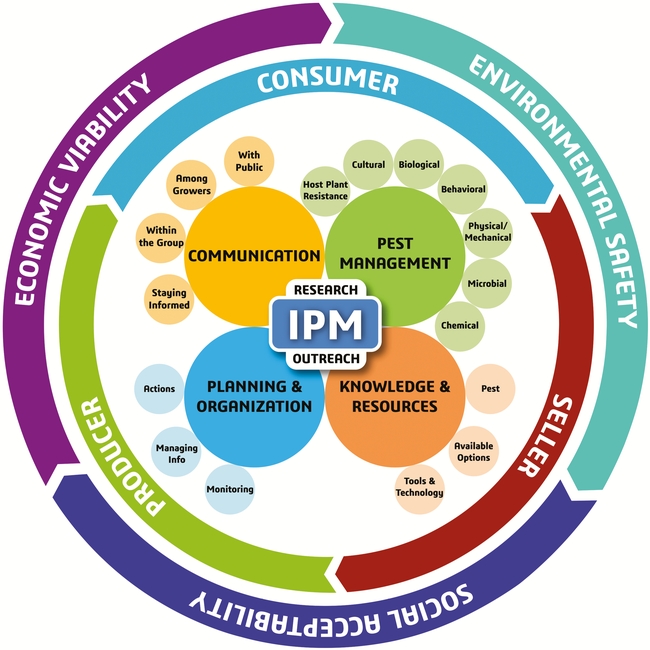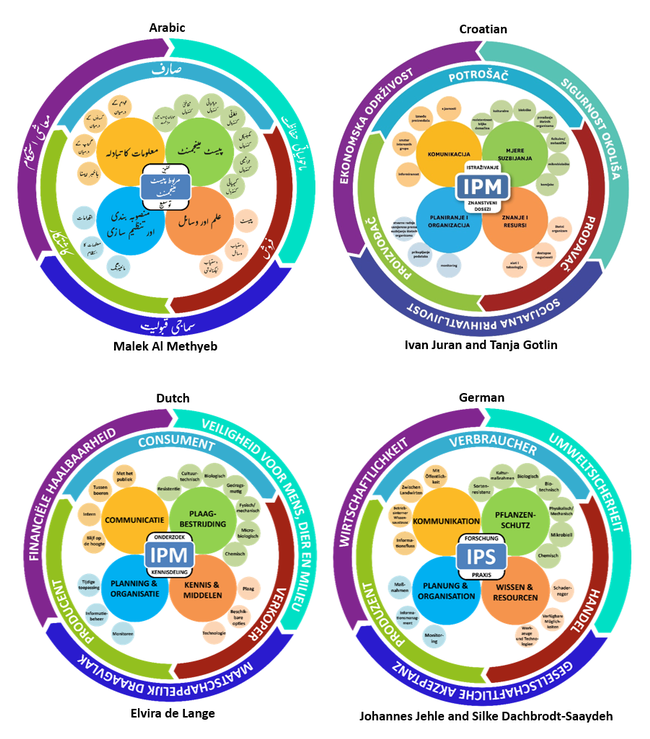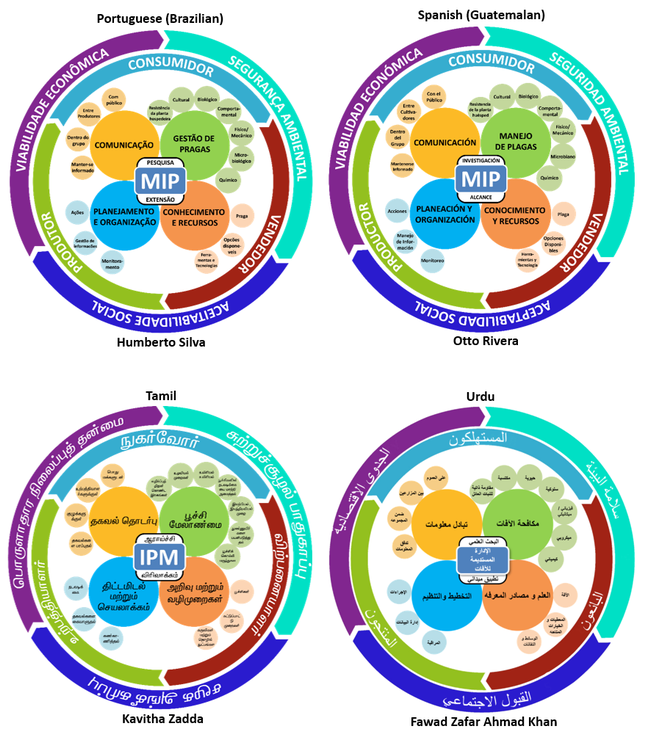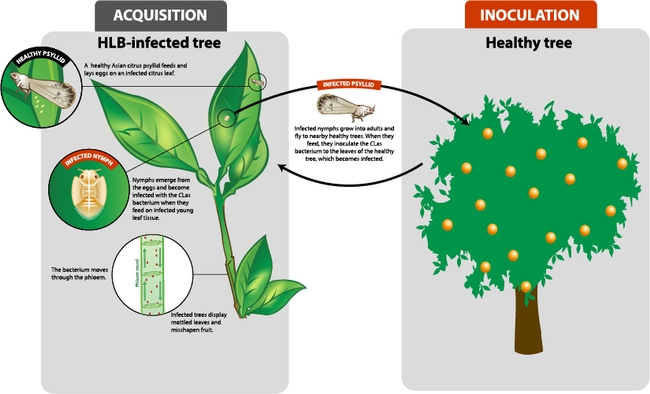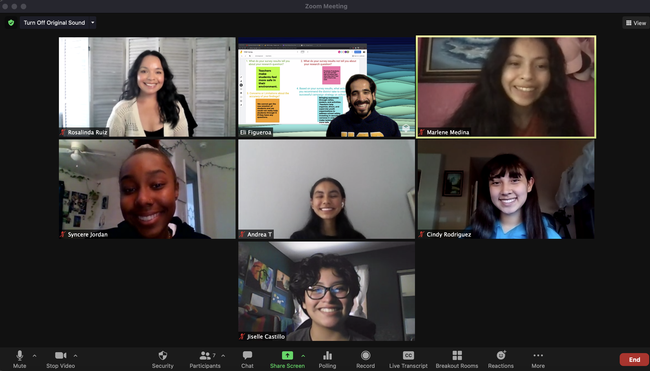- Author: Surendra K. Dara
Adapted IPM Model from former UC ANR faculty is offered in multiple languages leading to potential profit increases of $1.79 million.
The Issue
Numerous endemic and invasive pests threaten all kinds of crops, and the application of synthetic pesticides is the most common control option in many cases around the world. Frequent application of pesticides leads to pest resistance, secondary pest outbreaks, increased risk of environmental and human health, and negatively impact sustainable crop production efforts both in the short-term and long-term. Integrated pest management (IPM) is a concept of pest management in an ecologically sustainable manner. IPM has been promoted for decades, and many farms apply IPM practices to some extent. However, there are certain deficiencies in the understanding of IPM, its components, finding non-chemical management options, and exploiting cultural practices to improve crop health and yields. The traditional IPM model faces challenges because of its limitations for practical applications. There is a need to improve the understanding of growers, pest control advisors, and crop advisors in developing comprehensive crop care strategies using IPM principles, as well as revise the traditional IPM model to fit the modern production trends and consumer preferences.
How UC Delivers
Former UC ANR Cooperative Extension Advisor Dr. Surendra Dara conducted extensive research developing IPM solutions and promoting biological control options for small fruits and vegetables in California and provided advice for managing pests in nurseries, ornamental crops, urban landscapes as well. The ultimate goal is to improve IPM knowledge and implementation locally, regionally, nationally, and internationally. Based on his decades of research and extension experience in the US and other countries around the world, Dr. Dara developed the new IPM paradigm in 2019 that incorporated social and economic aspects of crop production in addition to various pest management options and other influencing factors. He had been invited by multiple groups to speak about IPM strategies in multiple crops and the new IPM model. Multiple symposia were organized at professional conferences, farmers, crop care professionals, and agricultural input industries updated their crop production and protection strategies based on the new IPM model. The model has been translated into multiple languages with international collaboration.
An anonymous online survey conducted between December 2021 and May 2022 received responses from California and elsewhere. Forty-five respondents from allover California, Arizona, Florida, Georgia, Hawaii, Indiana, Illinois, Michigan, Minnesota, North Carolina, Ohio, Oregon, South Carolina, Washington, and Wisconsin states in the US, and from Argentina, Australia, Ethiopia, Honduras, India, Kenya, Mexico, Mozambique, Nigeria, Pakistan, Portugal, Tanzania, and Uganda participated in the survey.
The Impact
Survey results showed that 95.6% found the information from Dr. Dara's IPM program was useful, and 93.3% people would use that information or have used it to improve their farming operations. The IPM information has been or would be used on 33,703 acres with a realized or expected savings or additional returns of $1.79 million. The respondents also indicated that they have or would share the information to 132,739 people. Survey respondents included farmers, pest control or crop advisors, private researchers, agricultural industry partners, and university faculty or researchers. Since it was published in the Journal of Integrated Pest Management in late April 2019, the new IPM model has been read or downloaded more than 48,000 times so far. Dr. Dara's research and extension demonstrates an ongoing commitment to UC ANR's public value of protecting natural resources in California and beyond.
Testimonials
“I have been growing strawberries for more than 20 years and worked with several farm advisors. Surendra is undoubtedly the best. He is the most productive and passionate about helping the farm industry.” Santa Maria Strawberry Grower
“IPM model is a very important tool that we can all promote to better implementation of efficient and sustianable solutions. thanks” Global Biocontrol Salesperson
“I am impressed with Dr. Dara's range and depth of trials, demonstrations, and experiments in the area of regenerative agriculture. The information he has put out is novel, useful and helpful. Sorry to see him go to Oregon.” Pest Control Advisor in USA
“Dr. Dara research is helping growers and crop consultants navigate sustainible and environmentally safe, effective and profitable options for pest managment in high value specialty crops.” Private Researcher, Hawaii, California, and Arizona
“Dr. Dara has a wealth of information that he distributes effectively using multiple different platforms. He is a good writer and communicator who is capable in presenting to audiences at various levels from growers to research scientists” Pest Control Advisor in the Western US
“Dr Dara is providing critical research and outreach for sustainable farming in the west and is also a linch pin in research and education on invasive pests.” Trade magazine editor
- Author: Peggy Goodenow Lemaux
After attending UC ANR's Science for Citrus Health webinars, over 50% of participating citrus professionals say they intend to adopt actions related to psyllid management. These practices can help safeguard abundant, healthy food for all Californians.
The Issue
Huanglongbing? Never heard of it? Why should I care? Maybe you need to learn more?
Huanglongbing, HLB, a bacterial disease of citrus also called Greening Disease, is spread by the Asian Citrus Psyllid. It causes the citrus fruits to be deformed and taste salty and bitter. HLB was first reported over a century ago in southern China. But why is it a problem for U.S. citrus? Diseases don't “respect” country borders and in 1998 the psyllid and the disease arrived in Florida in the early 2000's. Because there is no cure, damage caused in the largest orange producing state was extensive. By 2019, citrus production decreased in Florida by 74%. Despite federal bans on interstate movement of host plants, the psyllid did not abide by those rules!
And the disease also easily spreads from state to state. The first tree with HLB in California was found in 2012 in Los Angeles County. Then the question became, even though millions of research dollars were being spent, is there progress toward a cure? What could be done in California to slow the spread? Much was learned in Florida's battle and much is being learned through research. But it is hard for growers, the media, and the public to understand how that information might be used in California.
How UC Delivers
To address this information gap, Cooperative Extension Specialist Beth Grafton Cardwell and I started Science for Citrus Health (SCH) in 2015. It is designed to spread in lay language information about research aimed at understanding and combating HLB. SCH is now a cooperative effort with individuals from California, Florida and Texas, involving many activities.
These included developing Snapshots, short, two-page pieces on HLB research, written in lay language, posted on the SCH website, on Instagram, and disseminated at citrus meetings. In total, 45 Snapshots have been written, focusing on five themes related to detection, disease and psyllid management and the tools being used. Another resource for educational efforts is a large PowerPoint slide set, covering genetics, as well as regulatory and consumer issues. Recently efforts expanded, owing to grad students and postdocs, to include a YouTube channel on HLB and a popular podcast series that focuses on HLB researchers, their approaches and their career stories. Another effort involves translating citrus information and Snapshots into Spanish to reach Hispanic growers and workers in the citrus industry. In 2021, five informational webinars were convened on topics, such as ACP and HLB Management, the use of particle films to manage HLB, and citrus thrips. A recent webinar on the biology and management of ACP was presented in Spanish. These webinars attracted international audiences of up to 300 people.
The Impact
Post-meeting polls from UC ANR's Science for Citrus Health webinars indicated that more than 50% of attendees would implement at least one new practice they learned at the session. Research from the University of Florida has shown that the application of particle film screens, for example, has the potential to reduce ACP populations by more than 80% compared to monthly insecticide treatments, thereby contributing to UC ANR's public value of safeguarding abundant, healthy food for all Californians. Creation and proliferation of SCH efforts, providing information on research efforts focused on HLB, is an important educational resource for citrus growers, the media and industry. Another resource provides slides and educational materials to be used by educators for presentations to these groups, and the public. These newly created educational resources, some in Spanish, are unparalleled on other citrus sites.
- Author: Shannon A Klisch
- Author: Emily Dimond
- Author: Rosa Vargas
Partnering to support nutrition incentive programs at farmers markets provides increased access to healthy food for CalFresh recipients and generated over $380,000 in revenue for local farms.
The Issue
For low-income community members, CalFresh/SNAP incentive programs can increase their purchasing power, help reduce hunger, and improve nutrition. Farmers market nutrition incentives provide economic benefits to local farmers and communities, reduce food miles traveled, and can increase access to healthy food in low-income communities. In San Luis Obispo County eight year-round farmers markets accept CalFresh and offer the market incentive Market Match. However, these programs are underutilized, and many low-income shoppers are unaware or uncertain about where and how to use their CalFresh card.
How UC Delivers
To increase access to farmers market incentive programs and address barriers, UC staff convened partners through the EBT at Farmers Markets working group of the San Luis Obispo Food System Coalition. The work group includes partners from multiple sectors, including agriculture, government, private industry, and community-based organizations. The purpose of the work group is to increase the use of CalFresh at farmers markets to 1) create equitable access to healthy food and 2) support for local farmers. Through this work group, partners have collaborated to increase the visibility of farmers market incentives through social media, text messaging, materials distribution to local client-serving organizations, press releases, paid advertisements, and promotion at local food bank distributions and farmers markets.
Key work group partner representatives (n=6) were surveyed in September 2021 using the Wilder Collaboration Factors Survey. This survey includes 44 evidence-based items for collaboratives. Strengths are indicated by an average score of 4.0 to 5.0, while areas needing attention are 3.9 or lower. Strengths reported by respondents included: skilled leadership (4.3), unique purpose (4.3), mutual respect and trust (4.4). Weaknesses and areas of growth included: adequate funds (2.7) and time (2.7), and having all the organizations that we need as members of the group (3.2).
To address some of the issues related to time and resources, the work group applied for and received $30,000 in funding from the Danone Foundation to pilot a Farmers Market Navigator program to increase access to farmers market incentives among Hispanic and Latino customers who use CalFresh.
The Impact
Since 2017, when UC started convening the EBT at Farmers Markets work group, we have seen a 171% increase in CalFresh and Market Match redemption. Research has shown that access to fruits and vegetables supports healthy eating behaviors and improved health outcomes. Additionally, these purchases have generated a total of $386,000 in direct income to local farmers and farmers markets.
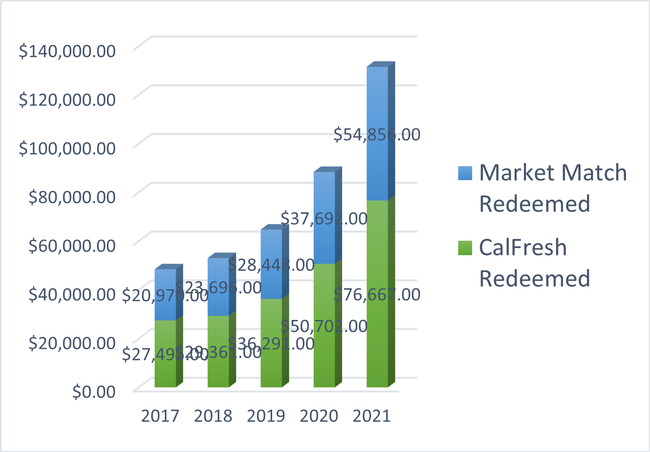
In addition, the work group has supported two additional markets in launching their Market Match program and has advocated for and achieved a regional standard incentive amount of $15 from Paso Robles in northern San Luis Obispo County to Lompoc in northern Santa Barbara County. This regional standard simplifies communication to low-income clientele and ensures a meaningful and standardized food budget when clients shop at local farmers markets.
Increasing access to local fruits and vegetables supports UC ANR's public values of safeguarding abundant and healthy food for all Californians and promoting healthy people and communities.
Our favorite quote:
“This work group really helped our market to be accepted into the Market Match program. I think without the visibility and partnership that this work group provided, we would not have been considered for Market Match. So you all should really feel good about that and thank you.”
– Farmers market manager and work group partner
- Author: Lorena Hoyos
- Author: Angie Keihner
- Editor: Andra Nicoli
Making Every Dollar Count participants reported running out of food before the end of the month significantly less often, suggesting an improvement in their families' food security.
The Issue
According to the California Association of Food Banks, one in five Californians struggled with food insecurity during 2020. Making Every Dollar Count (MEDC) is a curriculum that teaches adults food buying/budgeting skills and food and resource management techniques that can support limited-resource families. The primary tool for evaluating this curriculum is the MEDC retrospective survey. This survey primarily collects participant knowledge, limiting the program outcomes collected particularly regarding potential improvements in food resource management (FRM) behaviors. In addition, FRM behaviors are a key focus area identified in California's CalFresh Healthy Living statewide goals and objectives for FFY 2020-22.
How UC Delivers
During evaluation planning for FFY 2019-20, the CalFresh Healthy Living, UC State Office (CFHL, UC State Office) asked San Joaquin County if there was a possibility to transition from the MEDC survey to the Plan, Shop, Save and Cook (PSSC) evaluation tool to better capture food resource management (FRM) behavioral data. As a result, the CalFresh Healthy Living, UCCE San Joaquin team asked a long-time partner, First 5 of San Joaquin, if their MEDC-in-home educators could adopt the new survey. Given this new opportunity to capture FRM behavioral outcomes, First 5 approved the transition based on the recommendation of the CFHL, UC State Office in January 2020. FFY2020-21 was the first complete year in which the First 5 in-home educators used the PSSC evaluation tool for all participants that received MEDC lessons.
Preliminary results of the PSSC pre/post survey evaluating the MEDC curriculum delivery in San Joaquin County showed opportunity for capturing FRM behavioral outcomes related to MEDC. A total of 95 matched pre/post PSSC surveys were analyzed among the MEDC series participants.
Survey respondents were primarily female (95%) and all 18-59 years old. Most participants self-identified as Hispanic or Latino (88%).
The Impact
Adults (n=95) who participated in the Making Every Dollar Count series showed statistically significant improvements (p<.000) from the pre- to post- survey in how often they:
- Compared unit prices before buying food;
- Shopped with a grocery list;
- Thought about healthy food choices when deciding what to feed their family;
- Used the “Nutrition Facts” on the food label to make food choices;
- Used MyPlate to make food choices; and
- Used food resource management behaviors (plan, price, shop, think, fact).
The percent who reported improvements in these behaviors at five weeks post-series ranged from 88% (for thinking about healthy food choices when deciding what to feed their family) to 98% (for using MyPlate to make food choices). In addition, after attending the MEDC series, adult participants reported running out of food before the end of the month significantly less often (p<.000) suggesting an improvement in their families' food security.
Clientele Testimonials
Participants responded to the question, “What changes have you made since you have taken these classes?”
”Ahorrar dinero al hacer una lista de mis compras.”
Translation: “Save money by making a shopping list.”
“Aprendí a cuidar mi economía.”
Translation- “I learned to take care of my finances.”
These outcomes, along with efforts to understand the behavioral impacts of MEDC programming, are part of UC ANR's commitment to improving economic prosperity and securing safe, abundant food for all Californians.

- Author: Marisa Neelon
- Author: Eli Figuroa
- Co-PI: Charles Go
Teens enrolled in Contra Costa County's virtual YPAR series gained knowledge about the social determinants of health and explored career trajectories to address critical health issues in their community. These projects help to increase community health and wellness and promote college readiness and access
The Issue
The COVID-19 pandemic exposed health inequities associated with the social determinants of health (SDOH),1 which “are the conditions in the places where people live, learn, work, and play that affect a wide range of health and quality-of-life-risks and outcomes.”2 Educating young people about the SDOH and engaging them in youth-led research to address health issues in their community is essential in shaping their future education and career goals.
How UC Delivers
The pandemic presented challenges initiating and engaging students in educational programs such as a Youth-Led Participatory Action Research Project (YPAR) because of the transition to online learning. Meeting the challenge to pivot from in-person to virtual programming, the Contra Costa County YPAR coordinator successfully facilitated a 100% remote youth-led program during the 2020-2021 school year at a new site, Dozier Libbey Medical High School (DLMHS), in Antioch, California.
DLMHS is a charter school where 58.9% of students are socioeconomically disadvantaged.3 The school focuses on health and medicine and developing future health professionals and was selected because its mission and values align with CFHL, UC to help people lead healthier lives.
An existing relationship with a DLMHS teacher and 4-H parent led to a virtual meeting with the principal who agreed to offer a YPAR program at DLMHS. Students were recruited through the school website and social media platforms, and five teens from the 11th grade were interviewed and selected to join the program and were also enrolled in 4-H.
The YPAR coordinator and a colleague from Merced County met with the teen leaders weekly over Zoom. They used various educational tech tools to facilitate activities from the Community Futures, Community Lore's Nine Stepping Stones guides to educate student leaders about YPAR. To encourage critical thinking and learning, the coordinators assigned videos and readings for group discussion that addressed the SDOH. These activities exposed the teens to health inequities in their community to consider for their YPAR project and fueled their career aspirations to make a difference in individual and community health.
The Impact
After this program year, four of the five teens completed a survey. They reported learning about the SDOH and when asked what, if any, impact this project had on their future education plans or future career interests, responses included:
“This project has opened my eyes to many different issues in my community and I feel like in my future job/career interests I will bring these issues with me and try to make a change so new generations don't see the same issues that we did. I want to make a change with my line of study.”
“I want to be a Doctor of Internal Medicine due to the program since I have learned the factors in the environment that affect health and can even cause chronic conditions which could be prevented or alleviated with the right nutrition and physical activity.”
These responses indicate new learning about community health and wellness, as well as increased college readiness. Youth participating in YPAR projects focused on nutrition and physical activity interventions, have been shown to promote healthy weight and reduce the risk of chronic disease.4;5 UCCE Contra Costa County's effort demonstrate UC ANR's public value of Healthy People and Communities.
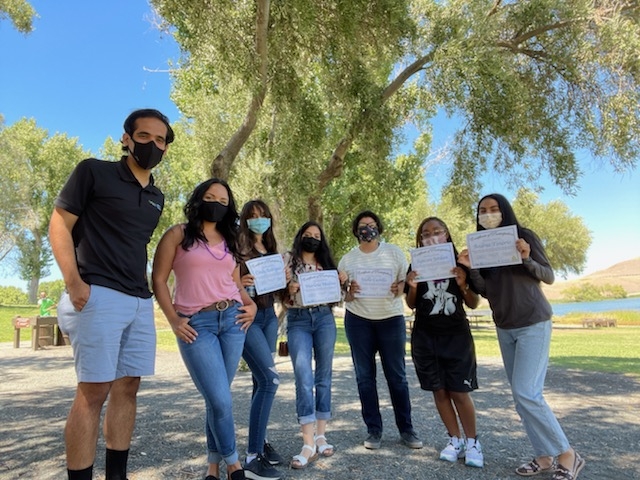
References
1. Abrams, E. M., & Szefler, S. J. (2020). COVID-19 and the impact of social determinants of health. The Lancet Respiratory Medicine, 8(7), 659-661.
2. Centers for Disease Control and Prevention. Social Determinants of Health: Know What Effects Health. https://www.cdc.gov/socialdeterminants/index.htm. Accessed September 7, 2021.
3. California Department of Education. California School Dashboard. 2020. https://www.caschooldashboard.org/reports/07616480117218/2020. Accessed September 7, 2021
4. Nour, M., Lutze, S., Grech A., & Allman-Farinelli, M (2018). The Relationship between Vegetable Intake and Weight Outcomes: A Systematic Review of Cohort Studies. Nutrients. 10(11), 1626.
5. US Department of Health and Human Services. Physical Activity Guidelines for Americans https://health.gov/sites/default/files/2019-09/Physical_Activity_Guidelines_2nd_edition.pdf. Accessed October 18, 2021.


